Our Lady of Czenstochowa Church
Coventry, Rhode Island
Kegg Pipe Organ Builders • Hartville, Ohio
By Charles Kegg
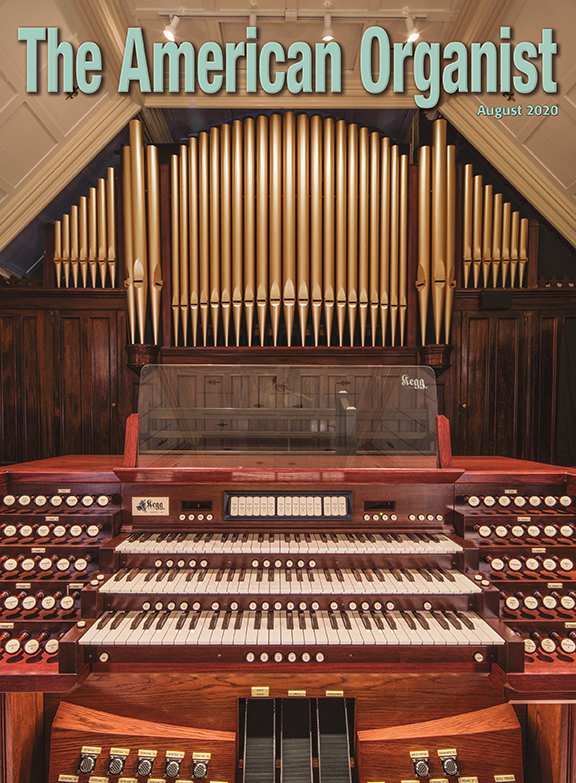
Each pipe organ we build brings something new to our table. Of course each instrument is different from any other we have built, but the relationship we have with Brian Mattias, director of music and organist at Our Lady of Czenstochowa Church, is also unique. Brian is an organbuilder, service technician, and owner of Potter-Rathbun Organ Company in Cranston, Rhode Island. He is active in the American Institute of Organbuilders, and I have known him for many years. Brian sees and hears new pipe organs from builders from all over the world at our annual conventions and had an unusually broad perspective when weighing the options regarding the builder for the new instrument for his church of birth, where he has been director of music for 32 years. It was indeed an honor to be chosen by someone as knowledgeable as he.
Brian had a long association with the previous 1927 Möller organ. He was quite fond of several of its 13 stops, and we agreed to include them in the new Kegg organ. Brian was intimately familiar with the Möller duplex pitman chests and knew that restoration was not an ideal long-term solution. Additionally, the organ’s tonal limitations clearly made a new organ the best option for his parish. Seven stops were retained in their entirety, while the Swell 16′ Bourdon 1–24 and the Great 8′ Melodia 1–31 were retained with new trebles. The Unda Maris is a vintage Möller Dulciana, identical to the original and provided out of Brian’s company’s stock. The majority of the 22 ranks in the new organ are new, as is the chassis and all the mechanics.
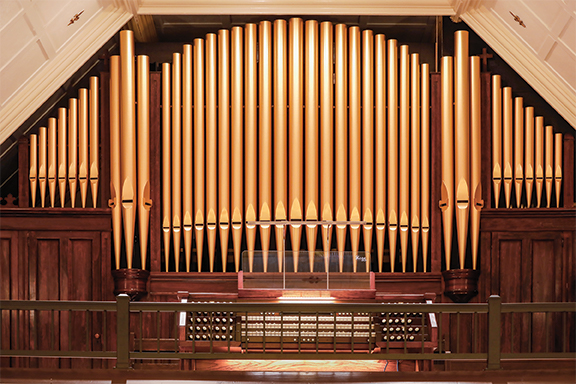
Like most organists I know, Brian really wanted a three-manual instrument. He had seen many examples of our small three-manual organs and suggested the same for himself. This is the smallest example of such a three-manual concept we have built, and with it we have stretched the boundaries of conventional organ design. All who have played the instrument agree that it succeeds as a three-manual organ. The entire instrument is enclosed in two expressive divisions, with the exception of the unenclosed Pedal 16′ Bourdon. The case and false facade pipes have been retained and restored. The third manual is called Choir and derives most of its stops from the Great. There are also several Swell stops that are duplexed onto this manual for convenience, including all the strings as well as the Oboe and the Cornet, which appear as a single stop. Of course this isn’t a proper independent division, but our way of building windchests allows us to create such a manual division at very low cost. The flexibility it provides makes this a most welcome addition.
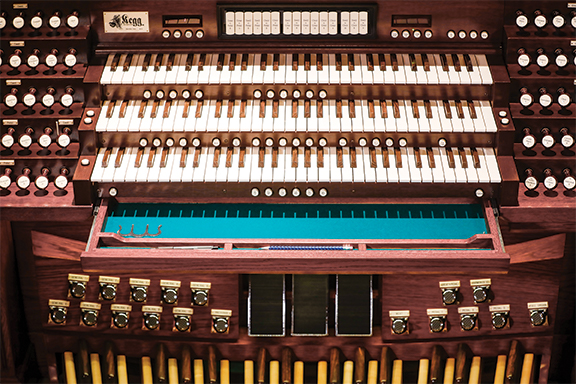
An unusual feature of this organ is the Swell Mixture. In our original proposal, the Swell had no Mixture. Of course the Great has a complete Principal chorus with Mixture IV. Brian had heard several examples of small Kegg organs in small rooms where we have provided a synthetic Mixture, drawn from an Octave and an independent Quint. He requested we do this for the Swell Mixture. It would have been a bit of a gamble, as the Diapason in the Swell was retained from the original Möller and is not scaled as would be a new Kegg organ with a synthetic Mixture. In the end, we used not the Diapason for the unisons of this “trick” Mixture, but the Viole d’Orchestre. The effect is charming and most useful in choral work.
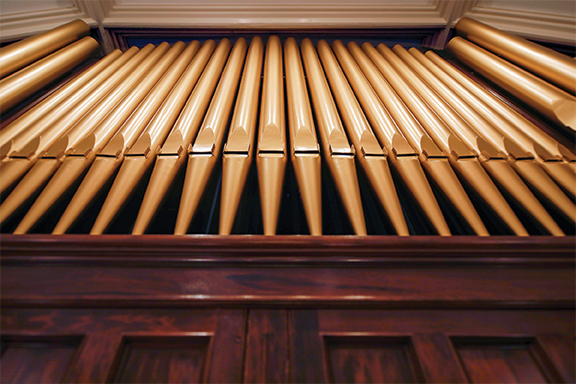
The Great has a new Principal chorus 8–4–IV as the backbone of the organ. The 8′ Concert Flute uses the bass of the existing Melodia for notes 1–31, with 32–73 being a new metal Harmonic Flute. We do this for entirely new stops as well. It gives the instrument a nice mf open wood 8′ flute, which is invaluable in both choral work and literature. The harmonic treble is treated as a true French-style stop where the volume ascends dramatically as you play up the keyboard. This gives this stop a beautiful solo quality, and with tremulant it is stunning. The new Clarinet is large, dark, and woody.
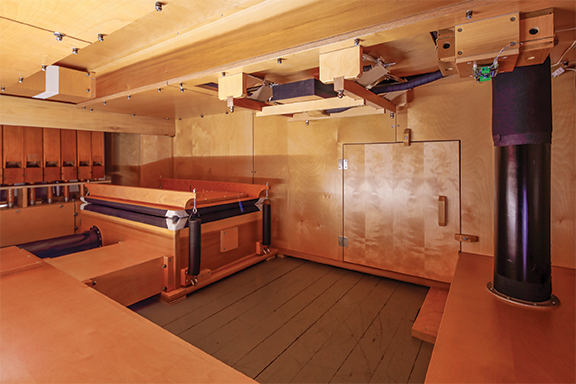
The three Swell strings, retained from the previous Möller, are delightful. Here again we retained the bass of the Möller 16′ Bourdon/Gedeckt, for notes 1–24. At middle C, it becomes a new metal Rohrflöte. The foundation flue stops have an additional octave of pipes at the treble to allow the octave coupler full compass on these stops to the top of the keyboard. The new Trumpet adds fire and exciting texture. The original Möller Oboe is an ideal Franck stop, as is the Möller Vox Humana.
“Full American couplers” may seem redundant and perhaps dangerous when an organ is designed this way. And frankly, it is both. Brian and I consumed much scotch during the discussions about this and all the other conventions abandoned on this organ. In the end, all the couplers are present for the clever musician who can use them with taste. I am constantly preaching, mostly to myself, that octave couplers are for special effects and not generally to be used at the end of every toccata and processional hymn.
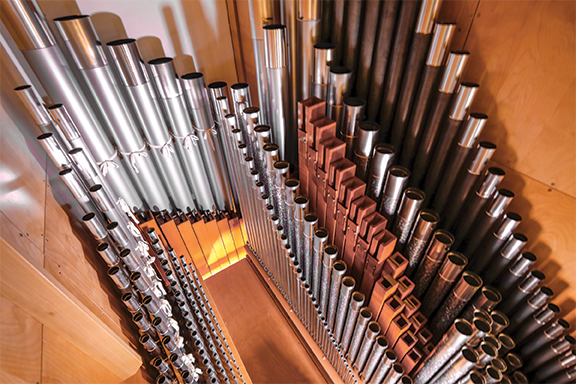
In these days of shrinking budgets, electronic 32s, and hybrid pipe/electronic designs, we believe that this all-pipe concept is a more honest, long-lived, and musically satisfying way to build a modest organ.
A couple of fun final thoughts: When the construction agreement was signed, Brian asked what the opus number of his organ would be. When I told him it would be Opus 61, we both smiled, as 61 is a number that appears frequently in organbuilding. (It is the number of keys in a five-octave keyboard.) Brian has taken great pleasure in this curious happenstance! Also, Brian and his daughters, Alana and Kira, spent a week at the Kegg shop during the organ construction. While there, Brian spent time at the CNC lathe turning the wood stop knobs for his own console, while Alana and Kira helped assemble small parts and glue wood ladders together. Thus they appear on the shop crew list below.
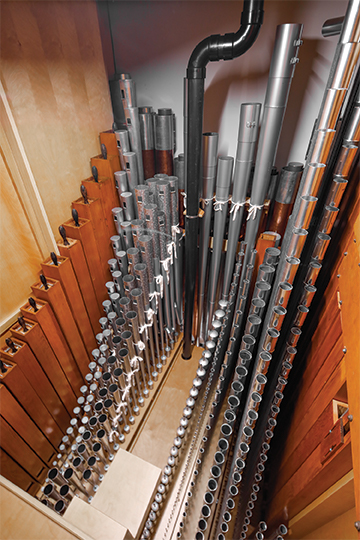
The new organ is to be dedicated by John Schwandt. This dedication has been postponed due to COVID-19 and will be scheduled when the world can return to normal.
Many thanks to our friends in Coventry, including Fr. Jacek Ploch, Brian Mattias, Brian’s helpful daughters, Alana and Kira, and the many parishioners that helped with unloading and their tremendous excitement and support.
Charles Kegg is president and artistic director of Kegg Pipe Organ Builders, which he established in 1985. The Kegg Company is a member of the Associated Pipe Organ Builders of America, and Charles is a past president of the American Institute of Organbuilders.
Website: KeggOrgan.com
Kegg Pipe Organ Builders
Charles Kegg
Phil Brown
Joyce Harper
Mike Carden
Phil Laakso
Bruce Schutrum
Cameron Couch
Brian Mattias
Alana Mattias
Kira Mattias
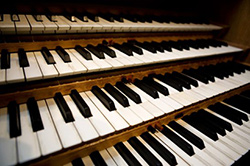

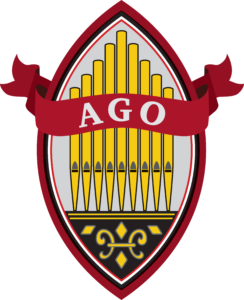
Leave a Reply